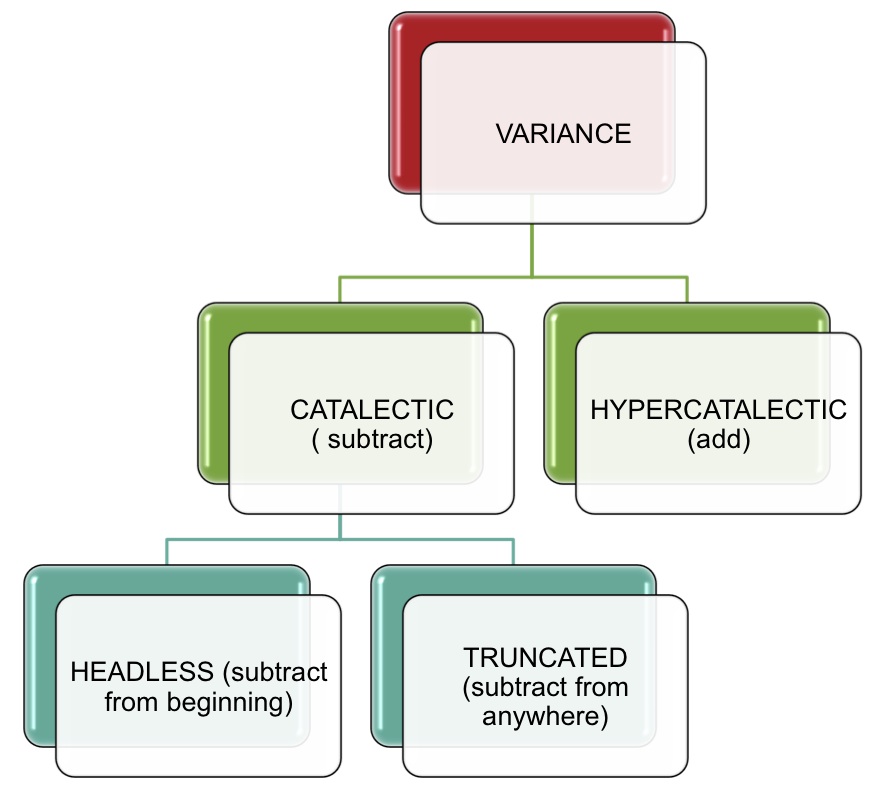105A. Metrical Variance: Deciding When & How to Vary Your Meter
Acatalectic
A perfectly formed line of Meter, with exactly the correct number of syllables in exactly the correct sequence is called Acatalectic.
 In 104A and 104B, we saw how Meter works and that different types of Meter are named based on the number of feet per line and the specific type of feet used. But contrary to popular belief, your story or poem doesn’t have to conform exactly to the chosen Meter. It can conform, and it is impressive when a poet forms consistently acatalectic lines. But almost all poets and children’s writers make occasional variations to the Meter. There are some variations that are so common– they have names. You don’t have to know these names, but pay attention to how the following examples exhibit varied Meter and how it affects or doesn’t affect the sound of the story or poem.
In 104A and 104B, we saw how Meter works and that different types of Meter are named based on the number of feet per line and the specific type of feet used. But contrary to popular belief, your story or poem doesn’t have to conform exactly to the chosen Meter. It can conform, and it is impressive when a poet forms consistently acatalectic lines. But almost all poets and children’s writers make occasional variations to the Meter. There are some variations that are so common– they have names. You don’t have to know these names, but pay attention to how the following examples exhibit varied Meter and how it affects or doesn’t affect the sound of the story or poem.
STRESSED SYLLABLES CANNOT BE VARIED!
 Remember that Variance applies only to UNstressed syllables. The rest of section 105 discusses how syllables can be varied, but this discussion refers ONLY ONLY ONLY to the variance of UNstressed syllables. Your Meter is essentially based on the number of STRESSED syllables in each line and this is something that you should not alter. In other words:
Remember that Variance applies only to UNstressed syllables. The rest of section 105 discusses how syllables can be varied, but this discussion refers ONLY ONLY ONLY to the variance of UNstressed syllables. Your Meter is essentially based on the number of STRESSED syllables in each line and this is something that you should not alter. In other words:
DON’T MESS WITH THE BOOT!
There are basically two ways to vary the Meter:
1. You can CUT syllables, or 2. You can ADD syllables

Headless and Truncated: A couple of terms that are good to know.
![]()
HEADLESS: A line of Meter is Headless when it is missing one or more syllables from the beginning of the line. This is just a specific type of Catalectic Meter
![]()
TRUNCATED: A line of Meter is Truncated when it is missing one or more syllables from the beginning, middle or end of the line. This is also just a type of Catalectic Meter.
Examples of Metrical Variations
There are people who will tell you that your Meter must be perfect to publish. I know this because about a hundred thousand people told me. Okay, so I don’t even know a hundred thousand people, but that’s how many times it feels like someone told me this. The truth is- most people don’t even know what “perfect meter” means. I don’t (and I know a lot about meter). Anyway, for argument’s sake, let’s say that “perfect meter” is Acatalectic Meter: Meter with exactly the correct number and type of syllables for a given established Meter. So, is it true? Does meter have to be acatalyctic to be publishable?
Here’s the reality: All of the examples below are from published and well-sold books. And none of them would be considered to have acatalyctic meter.
The truth: Meter can be varied. There are still rules and you should know them. But rest assured, your meter does not have to be perfect. These are the rules:
Headless Meter:


So, if we take a line of Meter, say, Anapestic Tetrameter, like this one:
And subtract the first UNstressed syllable like this:

Now add some actual words and it looks like this: “But wait,” you say, with a furrowed brow, “Dr. Seuss is famous for his rhyme and meter! Surely, this is a fluke; surely his rhyme and meter are perfect.” And I would say to that: There are approximately 46 lines of Headless Anapestic Tetrameter in The Cat in the Hat. You can choose to make every line of your meter Acatalectic if you want to, but there is nothing wrong with Headless Meter. It still sounds great. These lines are from Dr. Seuss’s The Cat in the Hat ( Random House 1957).
sounds great. These lines are from Dr. Seuss’s The Cat in the Hat ( Random House 1957).
Headless Meter can also eliminate the first TWO syllables of an Anapestic Meter, or the first syllable of an Iambic Meter so that the line starts on a STRESSED syllable. Look at the olive green box above and to the right. See how the line from Watch Your Tongue, Cecily Beasley is missing BOTH of the UNstressed syllables from the beginning of the line.
Truncated Meter:
The white text box to the right is missing a syllable at the end. This Meter is Trochaic Octameter so it STARTS on a STRESSED syllable.
Catalectic Meter
The box at the right shows a line of Anapestic Tetrameter that is missing a syllable from the middle of the line. As in the examples of Headless and Truncated Meters above, the missing syllable is an UNstressed one.
Quick recap:
All three of these examples are Catalectic Meter because they are missing syllables. Headless and Truncated Meters are still Catalectic in the same way that Terriers and Chihuahuas are still dogs. And Headless Meter is also Truncated in the same way that Yorkies are also Terriers. Catalectic is the least specific word for a line of Meter that is missing a syllable, and Headless is the most specific.
Also notice that Iambic and Anapestic Meters START with UNstressed syllables so they can be Headless, but because Dactylic and Trochaic Meters START with STRESSED syllables, they cannot be headless. You should NOT eliminate STRESSED syllables from your Meter. So likewise, Meters that end with STRESSED syllables cannot be truncated at the end, but remember that Truncated technically can mean that a line is missing a syllable at either the beginning or end.
Hypercatalectic Meter:
There are no specifics for Hypercatalectic Meter. It can mean an extra syllable at the beginning, middle, or end of a line of Meter. The passage at the right is Iambic Pentameter but it has an extra syllable at the beginning.
 The passage to the right shows a line of Anapestic Tetrameter with an extra syllable at the end. This line is from Dr. Seuss’s How the Grinch Stole Christmas (Random House 1957)
The passage to the right shows a line of Anapestic Tetrameter with an extra syllable at the end. This line is from Dr. Seuss’s How the Grinch Stole Christmas (Random House 1957)
If you read section 102: On Counting Syllables, you can see that Catalectic and Hypercatalectic lines will make syllable counting a ridiculous way to assess Meter. And here is a really good example of why that is: A line of meter can be both Hypercatalectic AND Catalectic! Really, it can. Here is an example of how it works: The line of Anapestic Tetrameter to the right is missing the first UNstressed syllable, so it is Headless/Catalectic. But it also has two extra syllables at the end, so it is Hypercatalectic.
Catalectic and Hypercatalectic lines will make syllable counting a ridiculous way to assess Meter. And here is a really good example of why that is: A line of meter can be both Hypercatalectic AND Catalectic! Really, it can. Here is an example of how it works: The line of Anapestic Tetrameter to the right is missing the first UNstressed syllable, so it is Headless/Catalectic. But it also has two extra syllables at the end, so it is Hypercatalectic.
![]()
Generally speaking, when adding UNstressed syllables to the middle of a line, you can only add one per foot.
And if you are adding them to the beginning or end of a line, you can only add as many as are in a foot of the line.
But there is no limit to how many feet you can vary. See 105B Mixed Meter for how this is done.

